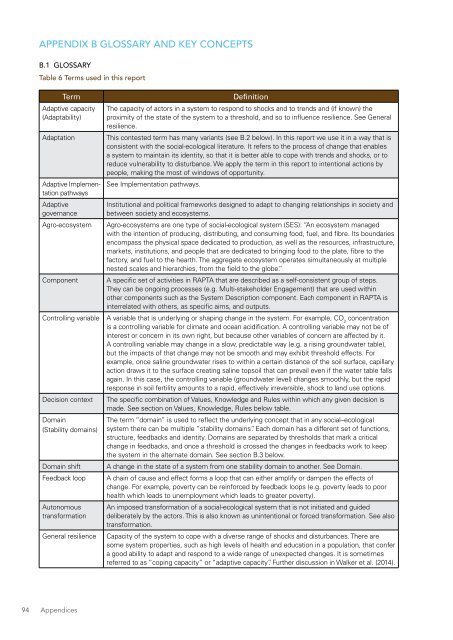DESIGNING PROJECTS IN A RAPIDLY CHANGING WORLD
srun3013fp1
srun3013fp1
You also want an ePaper? Increase the reach of your titles
YUMPU automatically turns print PDFs into web optimized ePapers that Google loves.
APPENDIX B GLOSSARY AND KEY CONCEPTS<br />
B.1 GLOSSARY<br />
Table 6 Terms used in this report<br />
Term<br />
Adaptive capacity<br />
(Adaptability)<br />
Adaptation<br />
Adaptive Implementation<br />
pathways<br />
Adaptive<br />
governance<br />
Agro-ecosystem<br />
Component<br />
Controlling variable<br />
Decision context<br />
Domain<br />
(Stability domains)<br />
Domain shift<br />
Feedback loop<br />
Autonomous<br />
transformation<br />
General resilience<br />
Definition<br />
The capacity of actors in a system to respond to shocks and to trends and (if known) the<br />
proximity of the state of the system to a threshold, and so to influence resilience. See General<br />
resilience.<br />
This contested term has many variants (see B.2 below). In this report we use it in a way that is<br />
consistent with the social-ecological literature. It refers to the process of change that enables<br />
a system to maintain its identity, so that it is better able to cope with trends and shocks, or to<br />
reduce vulnerability to disturbance. We apply the term in this report to intentional actions by<br />
people, making the most of windows of opportunity.<br />
See Implementation pathways.<br />
Institutional and political frameworks designed to adapt to changing relationships in society and<br />
between society and ecosystems.<br />
Agro-ecosystems are one type of social-ecological system (SES): “An ecosystem managed<br />
with the intention of producing, distributing, and consuming food, fuel, and fibre. Its boundaries<br />
encompass the physical space dedicated to production, as well as the resources, infrastructure,<br />
markets, institutions, and people that are dedicated to bringing food to the plate, fibre to the<br />
factory, and fuel to the hearth. The aggregate ecosystem operates simultaneously at multiple<br />
nested scales and hierarchies, from the field to the globe.”<br />
A specific set of activities in RAPTA that are described as a self-consistent group of steps.<br />
They can be ongoing processes (e.g. Multi-stakeholder Engagement) that are used within<br />
other components such as the System Description component. Each component in RAPTA is<br />
interrelated with others, as specific aims, and outputs.<br />
A variable that is underlying or shaping change in the system. For example, CO 2<br />
concentration<br />
is a controlling variable for climate and ocean acidification. A controlling variable may not be of<br />
interest or concern in its own right, but because other variables of concern are affected by it.<br />
A controlling variable may change in a slow, predictable way (e.g. a rising groundwater table),<br />
but the impacts of that change may not be smooth and may exhibit threshold effects. For<br />
example, once saline groundwater rises to within a certain distance of the soil surface, capillary<br />
action draws it to the surface creating saline topsoil that can prevail even if the water table falls<br />
again. In this case, the controlling variable (groundwater level) changes smoothly, but the rapid<br />
response in soil fertility amounts to a rapid, effectively irreversible, shock to land use options.<br />
The specific combination of Values, Knowledge and Rules within which any given decision is<br />
made. See section on Values, Knowledge, Rules below table.<br />
The term “domain” is used to reflect the underlying concept that in any social–ecological<br />
system there can be multiple “stability domains”. Each domain has a different set of functions,<br />
structure, feedbacks and identity. Domains are separated by thresholds that mark a critical<br />
change in feedbacks, and once a threshold is crossed the changes in feedbacks work to keep<br />
the system in the alternate domain. See section B.3 below.<br />
A change in the state of a system from one stability domain to another. See Domain.<br />
A chain of cause and effect forms a loop that can either amplify or dampen the effects of<br />
change. For example, poverty can be reinforced by feedback loops (e.g. poverty leads to poor<br />
health which leads to unemployment which leads to greater poverty).<br />
An imposed transformation of a social-ecological system that is not initiated and guided<br />
deliberately by the actors. This is also known as unintentional or forced transformation. See also<br />
transformation.<br />
Capacity of the system to cope with a diverse range of shocks and disturbances. There are<br />
some system properties, such as high levels of health and education in a population, that confer<br />
a good ability to adapt and respond to a wide range of unexpected changes. It is sometimes<br />
referred to as “coping capacity” or “adaptive capacity”. Further discussion in Walker et al. (2014).<br />
94 Appendices


